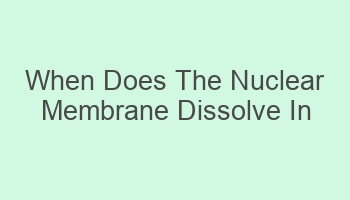When Does The Nuclear Membrane Dissolve In Mitosis?

When does the nuclear membrane dissolve in mitosis? The nuclear membrane dissolves during prophase. Mitosis is a crucial process in cell division, ensuring the accurate distribution of genetic material. This phase marks the beginning of nuclear breakdown, allowing chromosomes to condense and move freely. The dissolution of the nuclear membrane enables the spindle fibers to attach to the chromosomes. Without this dissolution, the separation of chromosomes during anaphase would be compromised. Understanding the timing of this event is essential for comprehending the precise sequence of mitosis. By knowing when the nuclear membrane dissolves in mitosis, researchers can gain insights into cell division regulation and potential abnormalities.
Contents
| Nuclear membrane dissolves in prophase of mitosis. |
| Allows spindle fibers to attach to chromosomes. |
| Helps in separation of genetic material. |
| Reforms after cell division is complete. |
| Protects DNA during cell division. |
- Nuclear membrane breakdown is critical for mitosis progression.
- Enables movement of chromosomes to opposite poles.
- Reintegration occurs in telophase of mitosis.
- Allows for formation of two daughter cells.
- Facilitates accurate distribution of genetic material.
Why Does The Nuclear Membrane Dissolve During Mitosis?
The nuclear membrane dissolves during mitosis to allow the chromosomes to condense and align properly for cell division. This breakdown of the nuclear envelope is essential for the separation of genetic material into two daughter cells.
- Ensures proper chromosome segregation
- Facilitates cell division process
- Allows for efficient distribution of genetic material
What Triggers The Dissolution Of The Nuclear Membrane In Mitosis?
The dissolution of the nuclear membrane in mitosis is triggered by the activation of specific enzymes, such as protein kinases, which phosphorylate nuclear pore proteins and lamins. This modification leads to the disassembly of the nuclear envelope.
| Enzymes activation | Phosphorylation of nuclear pore proteins |
| Lamin disassembly | Regulation of nuclear membrane breakdown |
How Does The Nuclear Membrane Reassemble After Mitosis?
The reassembly of the nuclear membrane after mitosis involves the recruitment of membrane vesicles and nuclear pore complexes to the chromatin. These components gradually envelop the genetic material, forming a new nuclear envelope around the daughter nuclei.
- Recruitment of membrane vesicles
- Formation of nuclear pore complexes
- Gradual envelopment of chromatin
Where Does The Nuclear Envelope Go During Mitosis?
The nuclear envelope does not disappear entirely during mitosis. Instead, it fragments into smaller vesicles that disperse throughout the cell. These vesicles are later incorporated into the newly forming nuclear membranes of the daughter cells.
| Fragmentation of nuclear envelope | Dispersion of vesicles |
| Incorporation into daughter cell membranes | Continuity of nuclear envelope structure |
When Does The Reformation Of The Nuclear Membrane Begin In Mitosis?
The reformation of the nuclear membrane begins in late telophase, following the completion of chromosome segregation. At this stage, the vesicles containing nuclear membrane components start to fuse and reform the nuclear envelope around the decondensing chromosomes.
- Late telophase initiation
- Fusion of membrane vesicles
- Reformation around decondensing chromosomes
How Does The Dissolution Of The Nuclear Membrane Impact Cellular Functions?
The dissolution of the nuclear membrane during mitosis has significant implications for cellular functions. It allows for the proper segregation of genetic material, ensuring the accurate transmission of genetic information to the daughter cells.
| Impact on genetic material segregation | Ensures accurate transmission of genetic information |
| Facilitates cell division process | Regulation of cellular functions |
Who Discovered The Role Of The Nuclear Membrane In Mitosis?
The role of the nuclear membrane in mitosis was discovered by scientists such as J. David Robertson and Keith W. Jones in the late 1960s. Their research on cell division mechanisms revealed the importance of nuclear envelope dynamics during mitosis.
- Contributions of J. David Robertson
- Discoveries by Keith W. Jones
- Advancements in cell biology research
Is The Dissolution Of The Nuclear Membrane Reversible In Mitosis?
The dissolution of the nuclear membrane in mitosis is a reversible process. Once cell division is complete, the nuclear envelope components reassemble around the daughter nuclei, restoring the integrity of the nuclear membrane for the next cell cycle.
| Reversibility of nuclear membrane dissolution | Restoration of nuclear envelope integrity |
| Cycle of membrane disassembly and reassembly | Cellular adaptation to mitotic processes |
Can The Nuclear Membrane Be Targeted For Therapeutic Interventions In Mitosis?
The nuclear membrane presents potential targets for therapeutic interventions in mitosis-related diseases. Modulating the dynamics of nuclear envelope breakdown and reformation could offer novel strategies for treating conditions associated with cell division dysregulation.
- Potential targets for therapeutic interventions
- Novel strategies for mitosis-related diseases
- Implications for future medical research